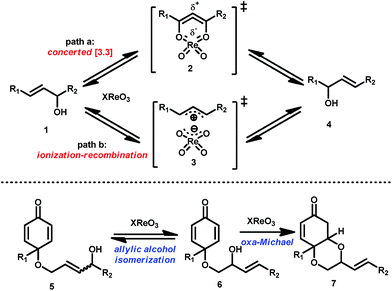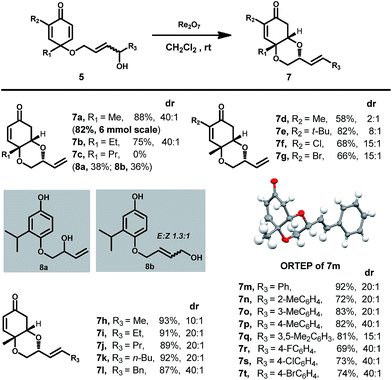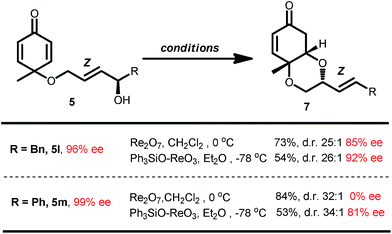Tandem allylic alcohol isomerization/oxo-Michael addition reaction promoted by Re2O7†
Jiadong Hua,
Dongyang Xub,
Qiang Zhangc,
Yang Shangb,
Mumin Shic,
Yucui Huangfuc,
Leilei Liuc,
Rong liangc,
Yisheng Lai*a,
Yupeng He*b,
Jin-ming Gaoc and
Weiqing Xie*cd
aState Key Laboratory of Natural Medicines, Jiangsu Key Laboratory of Drug Discovery for Metabolic Diseases, Center of Drug Discovery, China Pharmaceutical University, 24 Tongjiaxiang, Nanjing 210009, China. E-mail: yslai@cpu.edu.cn; Fax: +86-025-83271015; Tel: +86-025-83271015
bCollege of Chemistry, Chemical Engineering and Environmental Engineering, Liaoning Shihua University, Dandong Lu West 1, Fushun 113001, China. E-mail: yupeng.he@lnpu.edu.cn
cShaanxi Key Laboratory of Natural Products & Chemical Biology, College of Science, Northwest A&F University, 22 Xiong Road, Yangling 712100, Shanxi, China. E-mail: xiewq@sioc.ac.cn
dState Key Laboratory of Bioorganic & Natural Products Chemistry, Shanghai Institute of Organic Chemistry Chinese Academy of Sciences, 354 Fenglin Lu, Shanghai 200032, China
First published on 25th May 2016
Abstract
Re2O7 catalyzed tandem allylic alcohol isomerization/oxa-Michael addition reaction of cyclohexadienone was developed. The reaction features a regioselective and stereoselective isomerization of allylic alcohol and diastereoselective ring closure via oxa-Michael addition. This method also enabled construction of enantiopure bicyclic enones from substrates incorporated with chiral allylic alcohol via efficient chirality transfer.
The Re(VII)-oxo complex is well known as a competent catalyst for allylic alcohol isomerization under mild reaction conditions.1 It provides an efficient protocol for stereoselective preparation of hydroxylated molecules from easily available allylic alcohols. Unsurprisingly, its applications in total synthesis of natural products have also emerged.2 Based on experimental observation and theoretical studies,3 the reaction is proposed to proceed through a polarized, chairlike transition-state 2 (path a), which resembles that of [3.3]-rearrangement (Fig. 1). Therefore, the reaction usually resulted in high levels of E selectivity and high degree of chirality transfer when enantiopure substrates are used. However, formation of minor amount of Z isomer and slight decrease in enantiopurity of both allylic alcohols indicate that a ionization-recombination pathway via ionic intermediate 3 (path b), might be also involved in this process.1d,e Usually, the reaction results in mixture of two regioisomers due to the reversibility of the isomerization process and the product distribution mainly depends on the substrate structure. In this account, the reaction favourably generates isomers with extended conjugated system.1d,e Selective protection of less steric-hindered alcohol using BSA and TMSA in situ is also an elegant protocol for improving regioselectivity.1e
On the other hand, Re(VII)-oxo complex could also act as Lewis acid for promoting reactions such as acetalization, Prins cyclization.4 Therefore, allylic isomerization coupled with subsequent trapping of hydroxyl with appendage electrophile promoted by Re(VII)-oxo enables generating framework with increased complexity. In this respect, Zarkarian and co-workers elegantly described a cascade isomerization of allylic alcohol/acetalization reaction catalyzed by Re2O7, regioselectively and diastereoselectively delivering benzylidene acetal.5a More recently, Floreancig and co-workers developed a sequence of allylic alcohol transposition followed by nucleophilic addition to oxocarbenium to produce heterocycles with high level of regioselectivity and stereoselectivity.5b,d The same group also discovered that trapping of the putative cationic intermediate of allylic alcohol isomerization by epoxide could give polycyclic ethers with excellent stereoselectivities.5c
Desymmetrization of cyclohexadienone has provided quick access to bicyclic carbocycles.6 To this end, enantioselective cascade reactions terminated by Michael addition of cyclohexadienone have also been extensively studied recently.6 However, desymmetrization of cyclohexadienone by tandem oxa-Michael addition is sparingly reported.6e In line with our work on developing cascade process for generating polycyclic framework from simple precursor,7 we proposed that Re(VII)-oxo catalyzed allylic alcohol isomerization of cyclohexadienone 5 would deliver branched alcohol 6, which could undergo oxa-Michael addition promoted by Re(VII) catalyst to produce enone 7. Herein we would like to report our preliminary results on this tandem process.
To validate our hypothesis, cyclohexadienone 5a was initially prepared (see ESI†) and submitted to allylic alcohol isomerization conditions. Vanadium catalyst (O![[double bond, length as m-dash]](https://www.rsc.org/images/entities/char_e001.gif) VSO4 or POVO,8 Table 1, entry 2, 3) and methylrhenium trioxide (MTO, Table 1, entry 4),1 which are competent catalyst for allylic alcohol isomerization, were ineffective for this reaction with unchanged starting material recovered. To our delight, Osborn's catalyst (Ph3SiO–ReO3)1c could render the reaction complete in 1 h, affording enone 7a in 82% yield with 40
VSO4 or POVO,8 Table 1, entry 2, 3) and methylrhenium trioxide (MTO, Table 1, entry 4),1 which are competent catalyst for allylic alcohol isomerization, were ineffective for this reaction with unchanged starting material recovered. To our delight, Osborn's catalyst (Ph3SiO–ReO3)1c could render the reaction complete in 1 h, affording enone 7a in 82% yield with 40![[thin space (1/6-em)]](https://www.rsc.org/images/entities/char_2009.gif) :
:![[thin space (1/6-em)]](https://www.rsc.org/images/entities/char_2009.gif) 1 dr. The relative stereochemistry of 7a was tentatively established by analysis of its NOESY spectrum (see ESI†). The chairlike transition state I with an equatorial vinyl accounted for the high diastereoselectivity of this reaction, predominantly delivering thermodynamically stable product 7a. Further catalyst survey implied that commercial available Re2O7 was also a comparable catalyst (Table 1, entry 6), which was chosen as the optimal catalyst for this reaction. Solvent screening showed that halogenated solvents were superior to other solvents in terms of reaction rate and isolated yields, while CHCl3 gave deleterious isolation yield compared to CH2Cl2 (Table 1, entry 7). Furthermore, the catalyst loading could be as low as 2.5 mol% without slowing down reaction rate and diminishing isolated yield (Table 1, entry 12, 13).
1 dr. The relative stereochemistry of 7a was tentatively established by analysis of its NOESY spectrum (see ESI†). The chairlike transition state I with an equatorial vinyl accounted for the high diastereoselectivity of this reaction, predominantly delivering thermodynamically stable product 7a. Further catalyst survey implied that commercial available Re2O7 was also a comparable catalyst (Table 1, entry 6), which was chosen as the optimal catalyst for this reaction. Solvent screening showed that halogenated solvents were superior to other solvents in terms of reaction rate and isolated yields, while CHCl3 gave deleterious isolation yield compared to CH2Cl2 (Table 1, entry 7). Furthermore, the catalyst loading could be as low as 2.5 mol% without slowing down reaction rate and diminishing isolated yield (Table 1, entry 12, 13).
| Entry | Catalystd | Solvent | t (h) | 5ab (%) | Yieldb (%) |
|---|---|---|---|---|---|
a 5a (0.1 mmol) in 0.5 mL solvent was added to a solution of catalyst (10 mol%) in 0.5 mL solvent at rt.b Isolated yields.c Determined by 1H NMR using 1,4-dimethoxybenzene as inner standard.d 10 mol% catalyst loading.e 5 mol% catalyst loading.f 2.5 mol% catalyst loading.g dr 40![[thin space (1/6-em)]](https://www.rsc.org/images/entities/char_2009.gif) : :![[thin space (1/6-em)]](https://www.rsc.org/images/entities/char_2009.gif) 1 determined by 1H NMR. 1 determined by 1H NMR. |
|||||
| 1 | — | CH2Cl2 | 15 | 100 | 0 |
| 2 | O![[double bond, length as m-dash]](https://www.rsc.org/images/entities/char_e001.gif) VSO4 VSO4 |
CH2Cl2 | 15 | 100 | 0 |
| 3 | POVO | CH2Cl2 | 15 | 100 | 0 |
| 4 | MTO | CH2Cl2 | 15 | 100 | 0 |
| 5 | Ph3SiO–ReO3 | CH2Cl2 | 1 | 0 | 82g |
| 6 | Re2O7 | CH2Cl2 | 1 | 0 | 83 |
| 7 | Re2O7 | CHCl3 | 1 | 0 | 67 |
| 8 | Re2O7 | Toluene | 15 | 21 | 52c |
| 9 | Re2O7 | CH3CN | 15 | 43 | 35c |
| 10 | Re2O7 | EtOAc | 15 | 53 | 28c |
| 11 | Re2O7 | THF | 15 | 58 | 19c |
| 12e | Re2O7 | CH2Cl2 | 1 | 0 | 82 |
| 13f | Re2O7 | CH2Cl2 | 1 | 0 | 83g |
With the optimal reaction conditions identified, the substrate scope of this reaction was subsequently examined by varying the substituents on cyclohexadienone ring and allylic alcohol moiety (Table 2). The reaction turned out to be very sensitive to R1 (Tables 2 and 7a to 7c), as the isolated yields dramatically dropped when more bulky i-Pr was attached to cyclohexadienone ring. This could be ascribed to the competitive dienone-phenol rearrangement catalyzed by Re2O7, which generated 8a and 8b in 38% and 36% yields respectively.9 When unsymmetrical cyclohexadienones were employed (Table 2, 5d–5g), hydroxyl preferred to attack the unsubstituted enone due to steric repulsion, producing regioisomer 7d to 7g in acceptable yields with decreased diastereoselectivities. Different alkyl and electron-rich or electron-deficient arene on allylic alcohol moieties were compatible with the reaction conditions (Table 2 7h–7l and 7m–7t), stereoselectively and diastereoselectively furnishing the desired products with good to excellent yields. Only detection of E isomers indicated that the allylic alcohol transposition of this reaction was highly stereoselective. Eventually, gram scale synthesis of 7a was also implemented to show the synthetic potential of this reaction, which resulting in comparable isolated yield (82%, Table 2). The structure of the product was determined by 2D NMR studies and further confirmed by X-ray crystallographic analysis of 7m (see ESI†).10
To explore the efficiency of chirality transfer of this reaction,11 enantiopure substrates 5l and 5m were prepared and exposed to the reaction conditions. As shown in Fig. 2, 5l with a benzyl group on allylic position displayed higher degree of chirality transfer (Fig. 2, 96% ee to 85% ee), while only racemic product was obtained when chiral 5m was examined under the same conditions. Switch to Grubbs' conditions1d,e could greatly improve the extent of chirality transfer for 5m (Fig. 2, 99% ee to 81% ee). The slight loss of enantiopurity for 7l and 7m supported that ionization/recombination pathway, which caused racemization of allylic alcohol, might occur during the allylic alcohol isomerization process. As phenyl could stabilize the cationic intermediate, 5m exhibited less extent of chirality transfer than 5l. The absolute stereochemistry of 7l was assigned as (3R,4aS,8aR) based on ECD comparison between calculation and experimental spectra (see ESI†), indicating the retention of stereochemistry of hydroxyl during allylic isomerization.
Conclusions
We have developed a tandem allylic alcohol isomerization/oxa-Michael addition reaction of cyclohexadienone catalyzed by Re2O7. The reaction results in high level of stereoselectivity and diastereoselectivity. Transfer of chirality from cyclohexadienone embedded with chiral allylic alcohol to bicyclic enone could be efficiently achieved through cyclic chairlike transitions state. However, slight erosion of enantiopurity of the resulted enone suggested the partial involvement of ionization/recombination pathway.Acknowledgements
We are grateful for financial support from the National Natural Science Foundation of China (grand no. 21372239, 21202187) and the Scientific Research Foundation of Northwest A&F University (grand no. Z111021501, Z109021600).Notes and references
- For reviews: (a) S. Bellemin-Laponnaz and J. P. Le Ny, C. R. Chim., 2002, 5, 217 CrossRef CAS; (b) S. Bellemin-Laponnaz, ChemCatChem, 2009, 1, 357 CrossRef CAS; (c) S. Bellemin-Laponnaz, J. P. Le Ny and J. A. Osborn, Tetrahedron Lett., 2000, 41, 1549 CrossRef CAS; (d) C. Morrill and R. H. Grubbs, J. Am. Chem. Soc., 2005, 127, 2842 CrossRef CAS PubMed; (e) C. Morrill, G. L. Beutner and R. H. Grubbs, J. Org. Chem., 2006, 71, 7813 CrossRef CAS PubMed; for examples using others metal-oxo complexes, see: (f) S. Matsubara, T. Okazoe, K. Oshima, K. Takai and H. Nozaki, Bull. Chem. Soc. Jpn., 1985, 58, 844 CrossRef CAS; (g) S. Matsubara, K. Takai and H. Nozaki, Tetrahedron Lett., 1983, 24, 3741 CrossRef CAS; (h) T. Hosogai, Y. Fujita, Y. Ninagawa and T. Nishida, Chem. Lett., 1982, 357 CrossRef CAS; (i) J. Belgacem, J. Kress and J. A. Osborn, J. Am. Chem. Soc., 1992, 114, 1501 CrossRef CAS; (j) J. Belgacem, J. Kress and J. A. Osborn, J. Mol. Catal., 1994, 86, 267 CrossRef CAS; (k) F. R. Fronczek, R. L. Luck and G. Wang, Inorg. Chem. Commun., 2002, 5, 384 CrossRef CAS.
- (a) H. H. Jung, J. R. Seiders 2nd and P. E. Floreancig, Angew. Chem., Int. Ed., 2007, 46, 8464 CrossRef CAS PubMed; (b) I. Volchkov and D. Lee, J. Am. Chem. Soc., 2013, 135, 5324 CrossRef CAS PubMed.
- (a) S. Bellemin-Laponnaz, H. Gisie, J. P. LeNy and J. A. Osborn, Angew. Chem., Int. Ed., 1997, 36, 976 CrossRef CAS; (b) S. Bellemin-Laponnaz, J. P. Le Ny and A. Dedieu, Chem.–Eur. J., 1999, 5, 57 CrossRef CAS.
- (a) P. Ghorai and P. H. Dussault, Org. Lett., 2008, 10, 4577 CrossRef CAS PubMed; (b) K. Tadpetch and S. D. Rychnovsky, Org. Lett., 2008, 10, 4839 CrossRef CAS PubMed; (c) P. Ghorai and P. H. Dussault, Org. Lett., 2009, 11, 213 CrossRef CAS PubMed; (d) B. G. Das, R. Nallagonda and P. Ghorai, J. Org. Chem., 2012, 77, 5577 CrossRef CAS PubMed; (e) S. Pramanik and P. Ghorai, Chem. Commun., 2012, 48, 1820 RSC; (f) W. Sittiwong, M. W. Richardson, C. E. Schiaffo, T. J. Fisher and P. H. Dussault, Beilstein J. Org. Chem., 2013, 9, 1526 CrossRef PubMed; (g) S. W. Chavhan, C. A. McAdam and M. J. Cook, J. Org. Chem., 2014, 79, 11234 CrossRef CAS PubMed.
- (a) A. T. Herrmann, T. Saito, C. E. Stivala, J. Tom and A. Zakarian, J. Am. Chem. Soc., 2010, 132, 5962 CrossRef CAS PubMed; (b) Y. Xie and P. E. Floreancig, Chem. Sci., 2011, 2, 2423 RSC; (c) Y. Xie and P. E. Floreancig, Angew. Chem., Int. Ed., 2013, 52, 625 CrossRef CAS PubMed; (d) Y. Xie and P. E. Floreancig, Angew. Chem., Int. Ed., 2014, 53, 4926 CrossRef CAS PubMed.
- For reviews and references therein: (a) G. Maertens, M. A. Menard and S. Canesi, Synthesis, 2014, 46, 1573 CrossRef; (b) S. Barradas, M. C. Carreno, M. Gonzalez-Lopez, A. Latorre and A. Urbano, Org. Lett., 2007, 9, 5019 CrossRef CAS PubMed; (c) Q. Gu, Z. Q. Rong, C. Zheng and S. L. You, J. Am. Chem. Soc., 2010, 132, 4056 CrossRef CAS PubMed; (d) M. O. Ratnikov, L. E. Farkas and M. P. Doyle, J. Org. Chem., 2012, 77, 10294 CrossRef CAS PubMed; (e) D. M. Rubush, M. A. Morges, B. J. Rose, D. H. Thamm and T. Rovis, J. Am. Chem. Soc., 2012, 134, 13554 CrossRef CAS PubMed; (f) W. B. Wu, X. Li, H. C. Huang, X. Q. Yuan, J. Z. Lu, K. L. Zhu and J. X. Ye, Angew. Chem., Int. Ed., 2013, 52, 1743 CrossRef CAS PubMed.
- (a) F. Fan, W. Q. Xie and D. W. Ma, Org. Lett., 2012, 14, 1405 CrossRef CAS PubMed; (b) F. Fan, W. Q. Xie and D. W. Ma, Chem. Commun., 2012, 48, 7571 RSC.
- S. Akai, R. Hanada, N. Fujiwara, Y. Kita and M. Egi, Org. Lett., 2010, 12, 4900 CrossRef CAS PubMed.
- Z. Xia, J. Hu, Z. Shen, Q. Yao and W. Xie, RSC Adv., 2015, 5, 38499 RSC.
- ESI.†.
- For reactions with transfer of chirality via allylic alcohol isomerization, see ref. 1d–g.
Footnote |
| † Electronic supplementary information (ESI) available. CCDC 1470393. For ESI and crystallographic data in CIF or other electronic format see DOI: 10.1039/c6ra10399e |
| This journal is © The Royal Society of Chemistry 2016 |




